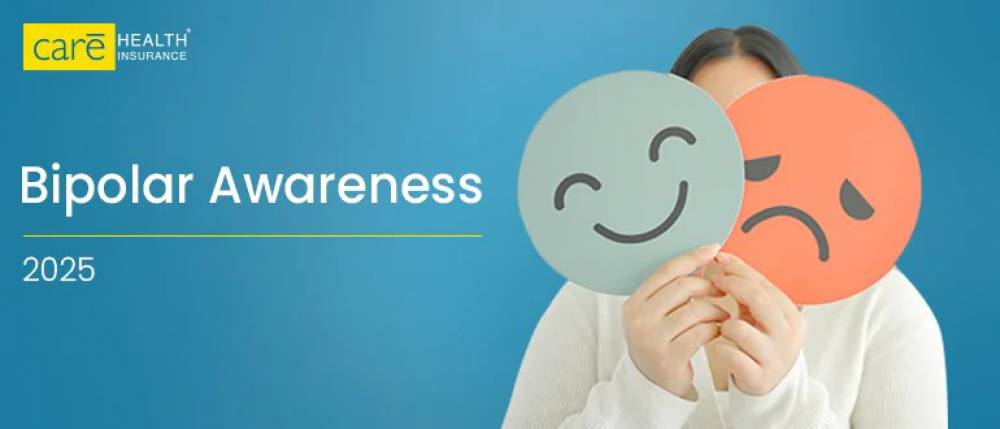Subscribe to get weekly insights
Always stay up to date with our newest articles sent direct to your inbox
Published on 26 Mar, 2025
Updated on 4 Apr, 2025
126 Views
4 min Read

Written by Yashita Sinha
Reviewed by Akhil Pillai
1Like
Did you know that Vincent van Gogh, one of the greatest artists in history, is believed to have had bipolar disorder? To honour his legacy and spread awareness about this condition, World Bipolar Day is observed every year on March 30th, his birthday. This day is a global initiative to educate people about this condition and eliminate its associated stigma by promoting early diagnosis and treatment.
In this blog, we’ll emphasise this year’s theme, the history of bipolar day, its importance and everything you need to know about bipolar disorder.
Formerly known as manic depression, bipolar disorder is a mental health condition associated with extreme mood swings. These include emotional highs, such as mania or hypomania, and lows, such as depression.
When experiencing mania, individuals may feel happy and excited, whereas depression is often accompanied by hopelessness. You tend to lose interest in things that you once found pleasurable. These mood swings can affect the sleep cycle, energy levels, judgment, behaviour and the ability to think straight.
There are three types of bipolar disorder, including:
While the exact causes of bipolar disorder are not fully understood, research suggests that the following factors may play a role:
Risk factors that may increase the likelihood of developing bipolar disorder or experiencing an initial episode include:
This year’s theme highlights the unity, resilience, and strength of individuals with bipolar disorder. It encourages them to share their experiences and spread awareness to combat stigma related to mental health. By fostering a strong sense of community, World Bipolar Day aims to enhance support and empathy for individuals with bipolar disorder. The themes from previous years were:
World Bipolar Day 2024 Theme: Bipolar Strong
World Bipolar Day 2023 Theme: Bipolar Together
Symptoms of bipolar disorder vary depending on the type of episode experienced. The table below describes the symptoms for each.
| Mood Episode | Common Symptoms |
|---|---|
| Manic Episode | Extreme energy and restlessness Feeling overly happy or irritable Risky behaviour (rash driving, impulsive decisions) Racing thoughts |
| Hypomanic Episode | Increased energy and activity Feeling unusually happy, confident, or productive Less need for sleep but still able to function No hospitalisation required |
| Depressive Episode | Constant sadness or hopelessness Fatigue and low energy Loss of interest in activities once enjoyed Changes in sleep Difficulty concentrating or decision-making Thoughts of self-harm or suicide in severe cases |
| Mixed Episode | Feeling restless and agitated High energy levels combined with negative emotions Increased risk of self-harm and impulsive decisions |
Here are some tests used to diagnose bipolar disorder:
A physical exam helps rule out other conditions that might cause similar symptoms. The doctor analyzes vital signs for substance abuse or other physical illnesses that could affect mood.
In this assessment, a mental health professional asks about mood swings, sleep patterns, and family history of mental illness to identify if symptoms are indicative of bipolar disorder and their impact on daily life.
Mood charting involves tracking mood, energy, and sleep patterns over time to identify manic or depressive episodes. This helps both the doctor and the individual understand the triggers, frequency, and intensity of symptoms.
Following a diagnosis, healthcare professionals determine the most suitable treatment plan based on the specific type of bipolar disorder. Here are the most common methods:
Medications, including mood stabilizers for mood swings, antipsychotics for manic episodes, and antidepressants for depression, are commonly prescribed.
Living with bipolar disorder can be overwhelming. Therefore, certain talk therapies, including Cognitive Behavioral Therapy (CBT), can help reduce negative thinking patterns.
Maintaining healthy lifestyle habits is crucial for overall mental health and can help manage bipolar disorder
In severe cases, especially during manic or depressive episodes, hospitalisation might be required for the safety and stabilisation of the affected individual.
Living with a serious mental health disorder like bipolar is a battle that you have to fight every day. With early diagnosis and suitable treatment, it’s possible to manage the symptoms. Although it cannot be completely cured with proper help and support you can overcome the disorder.
Getting suitable treatment can burn a hole in your pocket, therefore having a health insurance plan can help you protect your hard-earned savings and provide much-needed financial support so that you can focus on getting better.
Disclaimer: The above information is for reference purposes only. Kindly consult your general physician for verified medical advice. The health insurance benefits are subject to policy terms and conditions. Refer to your policy documents for more information.
शुगर कंट्रोल कैसे करे? जानें, डायबिटीज में क्या खाना चाहिए Care Health Insurance in Health & Wellness
Thyroid : मामूली नहीं हैं महिलाओं में थायराइड होना, जानें इसके लक्षण और घरेलू उपचार Care Health Insurance in Diseases
हाई ब्लड प्रेशर को तुरंत कंट्रोल कैसे करें? देखें इसके उपाय Care Health Insurance in Diseases
प्लेटलेट्स की कमी के लक्षण, कारण और इलाज क्या है Care Health Insurance in Diseases
World Chagas Disease Day: Understanding Global Health Impact of Kissing Bugs Care Health Insurance in Awareness Days
World Parkinson’s Day: Raising Hope for the Elderly Care Health Insurance in Awareness Days
ट्यूबरक्लोसिस (टीबी) के लक्षण, कारण और इलाज Care Health Insurance in Awareness Days
World Water Day 2025: Raising Awareness About the Global Water Crisis Care Health Insurance in Awareness Days